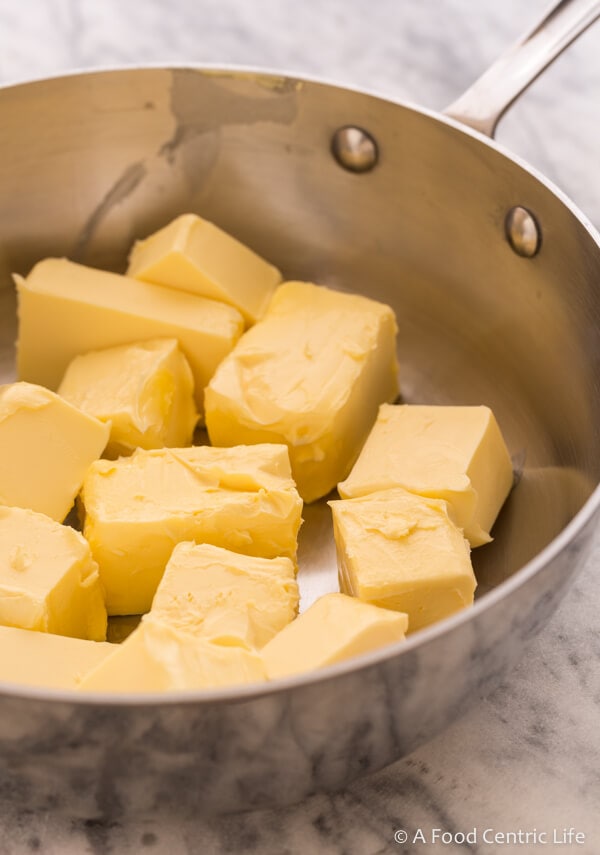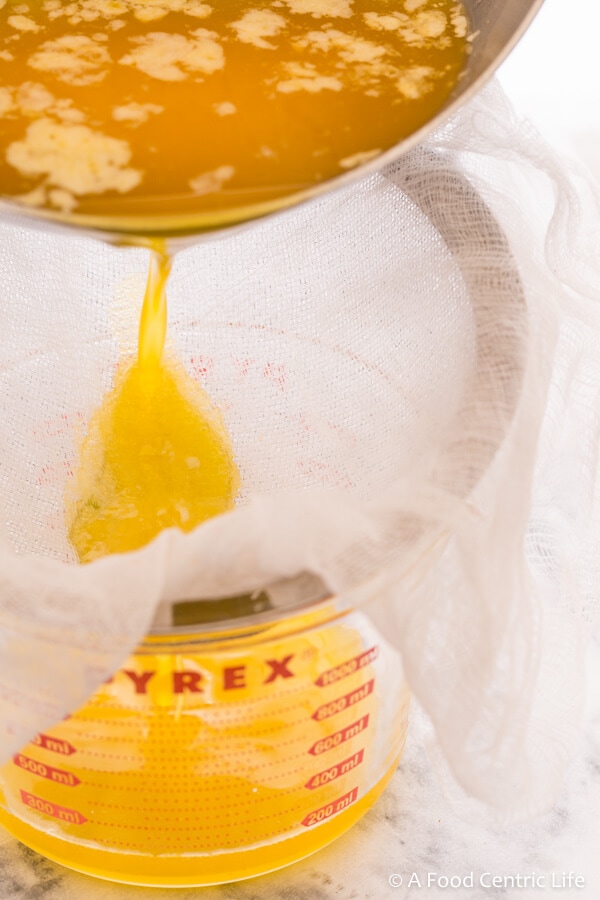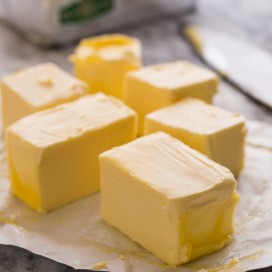Here is how to make clarified butter. Clarified butter is a pure cooking fat that many dairy-sensitive people have no problem with as clarifying remove the milk solids and water from butter. The best part is you still have that lovely buttery flavor in your diet. While you can buy it, it's easy to make at home in just a few minutes.

While I cook mostly with olive oil, sometimes only butter will do. Sometimes you just need the buttery taste that only butter provides. No explanation needed. Maybe it's to softly scrambled eggs or sauté mushrooms, make hollandaise or pan sear a steak. But what if you have eliminated dairy from your diet? What if you are dairy-sensitive?
What is Clarified Butter (Ghee)
While a stick of butter looks like solid fat, it's about 80% fat, 15% water and 5% milk solids. Clarified butter has the milk solids and water removed through cooking and straining, leaving a pure fat that is great to cook with. It's the milk solids that dairy-sensitive people often have a problem with.
Clarified butter is also known as ghee or ghee butter. It's an ingredient, truly an ancient health food, used traditionally in Indian cooking. While the terms are used interchangeably, the milk solids in ghee are cooked longer to develop a nutty flavor, and some Indian recipes add spices like turmeric.

Health Benefits of Clarified Butter
What about the saturated fat content of butter? The truth is, there is no good evidence proving the link between heart disease and saturated fat. To read the latest information on healthy fats in our diet, get a copy of Eat Fat Get Thin by Dr. Mark Hyman. Chapter 8 does a great job of explaining about clarified butter and it's role in a healthy diet.
Clarified butter can be a healthy fat if you eat a diet low in refined carbs, low in sugar and high in fiber. And clarified butter is thought to improve digestion, promote intestinal health, decrease inflammation, build strong bones and support weight loss. Oh, and it tastes great!

Why Clarify Butter
Two reasons. First, because clarified butter has a higher smoke point than regular butter. That is the point where a fat gets too hot and begins to break down, literally smoke, and become unhealthy. Clarified butter has a smoke point of about 450°F versus 350°F for regular butter, 320°F for extra virgin olive oil, 520°F for avocado oil or 350°F for unrefined coconut oil, so it can be used for higher temperature cooking.
Second, clarifying butter removes the milk solids leaving a pure fat. Many people who are lactose intolerant or dairy-sensitive find that they can enjoy clarified butter, as what they are sensitive to (casein and whey) has been removed.

About Butter and Saturated Fat
Buy only unsalted, organic or pastured butter to make clarified butter. Organic and pastured butter is free of growth hormones, antibiotics, harmful pesticides, GMOs and has a more healthful fat profile.
The quality of the butter produced from a cows milk is directly proportional to its diet. Whether grass-fed (pastured, good) or grain-fed from a CAFO (factory farm, not good), all butter is 50% saturated fat. The difference is that pastured butter has a healthy omega-6 to omega-3 fat profile, about 1:1, which is ideal. Butter from grain-fed cows has a much higher omega-6 ratio, and most Americans get too much omega-6 fats in their diet. Plus butter from cows on grain-fed, conventional diets can store pesticide residues and environmental toxins, not what you want in your butter.

How to Make Clarified Butter
It's a simple process. Melt unsalted butter in a small pan over low heat, then turn the heat up just a little and allow it to simmer on low for about 8-10 minutes longer. Bubbles will appear on the surface, at first large ones then smaller as the water cooks off. You will hear it too, as the bubbling almost stops.
A creamy white foam will develop on top, which is the milks solids separating from the butter fat. The milk solids are what burn when you cook with butter at high of heat. You will also see the clear golden butterfat underneath. The aroma of the melting butter will change a bit, developing a slightly nutty fragrance (think of browned butter).
Carefully pour the melted butter through a fine sieve lined with four layers of cheese cloth into a glass jar. When you get to the bottom of the pan, leave the solids behind if there are any. You should have pure, clear, golden butter fat. You will lose about 20%-25% of the original weight. While some sites say it does not need to be refrigerated, I prefer to refrigerate mine. It lasts about 6 months.
📖 Recipe

How to Make Clarified Butter (Ghee)
Equipment
- Cheesecloth
Ingredients
- 8 ounces unsalted pastured organic butter
Instructions
- Place butter in a small 2-quart pan over low heat. Melt the butter slowly. When the butter is melted, turn the heat up just a bit and allow the butter to slowly simmer to cook off the water and separate out the milk solids, about another 8-10 minutes. At first the bubbles will be large, then smaller as the water evaporates, and the bubbling gets more quiet.
- When the bubbles are very small and most of the water has evaporated and a whitish foam has developed on top (the milk solids), carefully pour the clarified butter through a fine sieve lined with 4 layers of cheesecloth. You should have pure clear golden fat.
- Pour into a small jar and refrigerate for 3-6 months. Use as desired for cooking.
Comments
No Comments